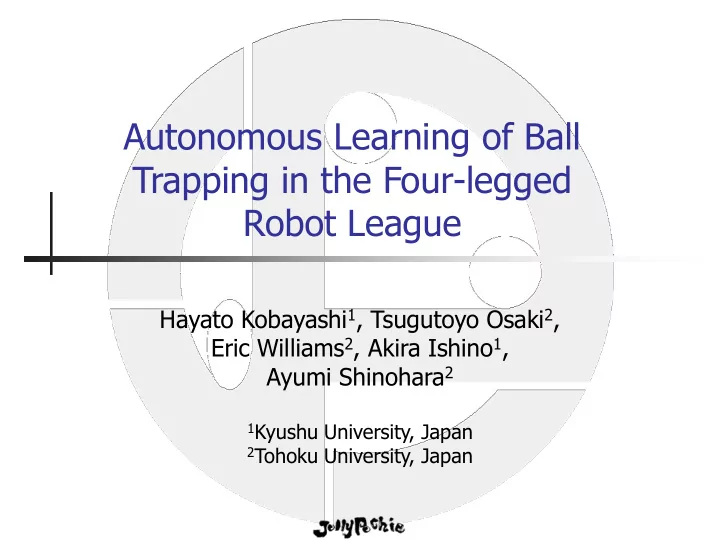

Autonomous Learning of Ball Trapping in the Four-legged Robot League Hayato Kobayashi 1 , Tsugutoyo Osaki 2 , Eric Williams 2 , Akira Ishino 1 , Ayumi Shinohara 2 1 Kyushu University, Japan 2 Tohoku University, Japan
Motivation Passwork in the four-legged robot league KeepAway Soccer [Stone et al. 2001] Benchmark of good passing abilities in the simulation league Passing Challenge Technical challenge in this year It is too difficult for dogs KeepAway Soccer http://www.cs.utexas.edu/~AustinVilla/sim/keepaway/
Ball Trapping Stop and control an oncoming ball
One-dimensional Model The passer is watching the chest of the receiver. The receiver is watching the ball.
Autonomous Method Same way as diligent humans Kick Wall
Training Equipment Limit ball ’ s movement and robot ’ s locomotion to one-dimension Slope made of cardbord Rails made of string
Learning Method Sarsa(λ) [Rummery and Niranjan 1994; Sutton 1996] Reinforcement learning algorithm Tile-coding (aka CMACs [Albus 1975] ) Linear function approximation For speeding up their learning
Reinforcement Learning Acquire maps from state input to action output maximizing the sum of rewards reward r 1 t Agent action Environment a (AIBO) t state s t In our study, each time step t = 0, 1, 2, … mean 0ms, 40ms, 80ms, …
Implementation State s t = ( x t , dx t ) x t ・・・ The distance from the robot to the ball [0,2000] ( mm ) dx t ・・・ The difference between the current x t and the previous x t of one time step before. [-200,200] ( mm ) Action a t ready ・・・ Move its head to watch the ball trap ・・・ Initiate the trapping motion
Implementation Reward r t+1 Positive If the ball was correctly captured between the chin and the chest after the trap action. Negative If the trap action failed, or If the ball touches the chest PSD sensor before the trap action is performed. Zero Otherwise
Implementation Episode The period from kicking the ball to receiving any reward other than zero Trap! Kick!
Experiments Using one robot Using two robots without communication with communication
Using One Robot Earlier phase https://youtu.be/hv1sgIZLpKA
Using One Robot Later phase https://youtu.be/XJBllv7wJXQ
Result of Learning Using One Robot trapping success rate every 10 episodes 100 80 60 traping success rate 40 20 0 0 50 100 150 200 250 300 350 episodes
Episodes 1 … 50 Result of each episode ● successful × failed in spite of trying 200 failure success ▲ failed because of doing nothing collision 150 100 50 dx 0 -50 -100 -150 -200 0 500 1000 1500 2000 x
Episodes 51 … 100 Result of each episode ● successful × failed in spite of trying 200 failure success ▲ failed because of doing nothing collision 150 100 50 dx 0 -50 -100 -150 -200 0 500 1000 1500 2000 x
Episodes 101 … 150 Result of each episode ● successful × failed in spite of trying 200 failure success ▲ failed because of doing nothing collision 150 100 50 dx 0 -50 -100 -150 -200 0 500 1000 1500 2000 x
Episodes 151 … 200 Result of each episode ● successful × failed in spite of trying 200 failure success ▲ failed because of doing nothing collision 150 100 50 dx 0 -50 -100 -150 -200 0 500 1000 1500 2000 x
Using Two Robots Simply replace slope with another robot Active Learner (AL) Original robot Same as in case of training using one robot Passive Learner (PL) Replaces slope Does not approach the ball if the trapping failed
Using Two Robots Earlier phase https://youtu.be/sXkVYZjOzjg
Using Two Robots Later phase https://youtu.be/opvoyv9h-GU
Result of Learning Using Two Robots Without Communication trapping success rate every 10 episodes 100 AL PL 80 Active Learner Passive Learner 60 traping success rate 40 20 0 0 50 100 150 200 250 300 350 episodes
Problem of Using Two Robots Takes a long time to learn AL can only learn when PL itself succeeds Cannot learn if the ball is not returned Even if we use only two ALs, the problem is not resolved Just learn slowly, though simultaneously.
Solution Sharing their experiences Their experiences include Action a t ( trap or ready ) State variables s t =( x t ,dx t ) Reward r t+1
Result of Learning Using Two Robots With Communication trapping success rate every 10 episodes 100 AL PL 80 Active Learner Passive Learner 60 traping success rate 40 20 0 0 50 100 150 200 250 300 350 400 episodes
Conclusion The goal of pass-work is achieved in one-dimension learned the skills without human intervention learned more quickly by exchanging experiences with each other
Future Work Extend trapping skills to two-dimensions Layered Learning [Stone 2000] Make goalies stronger Make robots learn passing skills simultaneously
Thank you for your attention! Bremen is a good town!
Recommend
More recommend